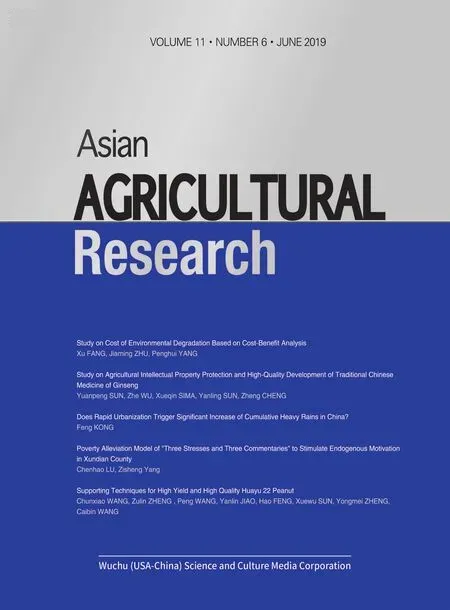Supporting Techniques for High Yield and High Quality Huayu 22 Peanut
2019-07-30ChunxiaoWANG1ZulinZHENG2PengWANG1YanlinJIAO1HaoFENGXuewuSUNYongmeiZHENGCaibinWANG
Chunxiao WANG1, Zulin ZHENG2 , Peng WANG1, Yanlin JIAO1, Hao FENG*, Xuewu SUN, Yongmei ZHENG*, Caibin WANG
1. Yantai Academy of Agricultural Sciences, Yantai 265500, China; 2. Weifang Food and Drug Inspection and Testing Center, Weifang 261100, China; 3. Shandong Peanut Research Institute, Qingdao 266100, China
AbstractThis paper mainly studied the effects of different sowing dates and densities on the main agronomic traits and yield of Huayu 22 peanut under field conditions. The sowing date experiment obtained following results. (i) From April 25 to May 25, with the delay of the sowing date, the main stem height, the number of branches per plant, the number of pods per plant, full-seed pod rate and the yield decreased in Dongming test site, while the sowing date had little effect on the double-seed pod rate, and the best sowing date was April 25; in Wendeng test site, with the delay of the sowing date, the main agronomic traits and yield were firstly increased and then decreased, the yield was highest on May 10, followed by May 5 and April 30, the difference between the three treatments was not significant, and the appropriate sowing date was from April 30 to May 10, and the best sowing data was May 5. (ii) In the range of 90 000-210 000 holes/ha, with the increase of the density, the main stem height, lateral branch length and the number of pods per plant showed a decline trend, the density had little effect on the number of branches per plant, and the double-seed pod rate was the highest at 120 000 holes/ha, the yield and full-seed pod rate were the highest at 150 000 holes/ha, so the optimum density was 150 000 holes/ha.
Key wordsPeanut, Sowing date, Density, Supporting techniques
1 Introduction
Huayu 22 Peanut, bred by Shandong Peanut Research Institute, belongs to ordinary large variety of peanut with the highest yield up to 11 289 kg/ha, making a new record of high yield of peanut[1]. Since the Eleventh Five-Year Plan, Huayu 22 Peanut has been determined by Shandong Province as major variety for popularization. Study on supporting techniques for Huayu 22 is favorable for further exploring the potential of its yield increase. In peanut cultivation techniques, sowing date and density are important factors affecting peanut yield, and they have attracted the attention of many scholars. Appropriate sowing date has strong regional characteristics. For spring sowing peanut, in Henan Province, the appropriate sowing date for Zhumadian is May 30-June 9[2], for Zhengzhou, it is May 10[3], for Jiaozuo, it is May 1-June 10[4]; in Shandong Province, the appropriate sowing date for Jining is April 25-May 5[5], for Qingdao, it is May 1-10[6]; in Fujian Province, the appropriate sowing date for Hui’an is early March[7]; in Hebei Province, the appropriate sowing date for Tangshan is April 28 Day-May 8[8]; in Jilin Province, the appropriate sowing date for Changchun is May 5[9], Tai’an is May 5[10], and for Zhangjiakou, it is May 1[11]; in northern Xinjiang, the appropriate sowing date is May 7[12]. The above studies provide technical support for appropriate sowing date in different producing areas. Shandong Province is the main peanut producing area in China. The climate difference is large between the east and the west of Shandong Province, and there is a certain difference in the appropriate sowing date. Thus, it is necessary to make further study. The appropriate density of peanuts is mainly related to the morphological characteristics, growth habits and planting system of the peanut cultivars, and is mainly affected by such factors as the number of branches, growth status of the above-ground part, and the accumulated temperature during the growth period[13]. At present, there have been extensive studies about the relationship between the density of different varieties and the growth and yield of peanuts[14-23], which provides reasonable group indicators for guiding high-yield and high-quality cultivation of different varieties in different producing areas. In this study, we studied the effects of appropriate density on spring sowing of ordinary high quality and high yield large Huayu 22 Peanut and effects of appropriate sowing date in different ecological conditions of east and west of Shandong Province, to further explore the yield increase potential and provide a certain basis for high yield cultivation of the same variety peanuts.
2 Materials and methods
2.1 Overview and design of the experimentThe experiment was carried out at Wangguanying Village, Dongmingji Town, Dongming County, Heze City, Fanjiadian Village, Wendengying Town, Wendeng District, and Shandong Qingfeng Seed Co., Ltd. (Pingdu). The test variety was Huayu 22 Peanut. The experiment included sowing date test and density test. The sowing date test was carried out in Dongming and Wendeng, including seven sowing date treatments: April 25, April 30, May 5, May 10, May 15, May 20, and May 25. The density test was carried out in Pingdu, including five treatments: 90 000 holes/ha, 120 000 holes/ha, 150 000 holes/ha, 180 000 holes/ha and 210 000 holes/ha. Both tests were carried out using a randomized block design with the block area of 20 m2and repeated three times. We adopted spring sowing plastic-mulching cultivation, with the ridge spacing of 85-90 cm, 50 cm wide ridge surface, two rows per ridge, row spacing of 30 cm, and 15 cm hole spacing for sowing date test, and different hole spacings for density test, and two seeds for each hole. Before ridging, we uniformly applied NPK compound fertilizer 750 kg/ha (N, P, and K content ≥15%), and mixed into 0-30 cm soil. Field management was the same as the high yield field.
2.2 Determination of agronomic traits and yieldWhen the peanuts were harvested, we measured the main stem height, the lateral branch length, the number of branches per plant, the number of pods per plant, and the full-seed pod rate, and calculated the yield with the block as the unit.
2.3 Data processingWe used Excel, DPS and SPSS software to process and analyze data.
3 Results and analysis
3.1 Effects of sowing date on Huayu 22 Peanut
3.1.1Effects on agronomic traits. From Table 1, it can be seen that, with the delay of sowing date, in Dongming test site, the main stem height decreased, the number of branches per plant decreased, the number of pods per plant and the full-seed pod rate decreased, while the double-seed pod rate was not affected. This indicates that the delay of sowing date is not favorable for the growth and development of plant vegetative. Different from the Dongming test site, the main agronomic traits of the Wendeng test site increased first and then decreased with the delay of planting time. Specifically, the sowing date of May 5 had the main stem height, number of branches, and the number of pods per plant, showing the best performance; the sowing date of May 20 had the highest double-seed pod rate; the sowing date of May 10 had the highest full-seed pod rate.
Table 1 Effects of sowing date on agronomic traits
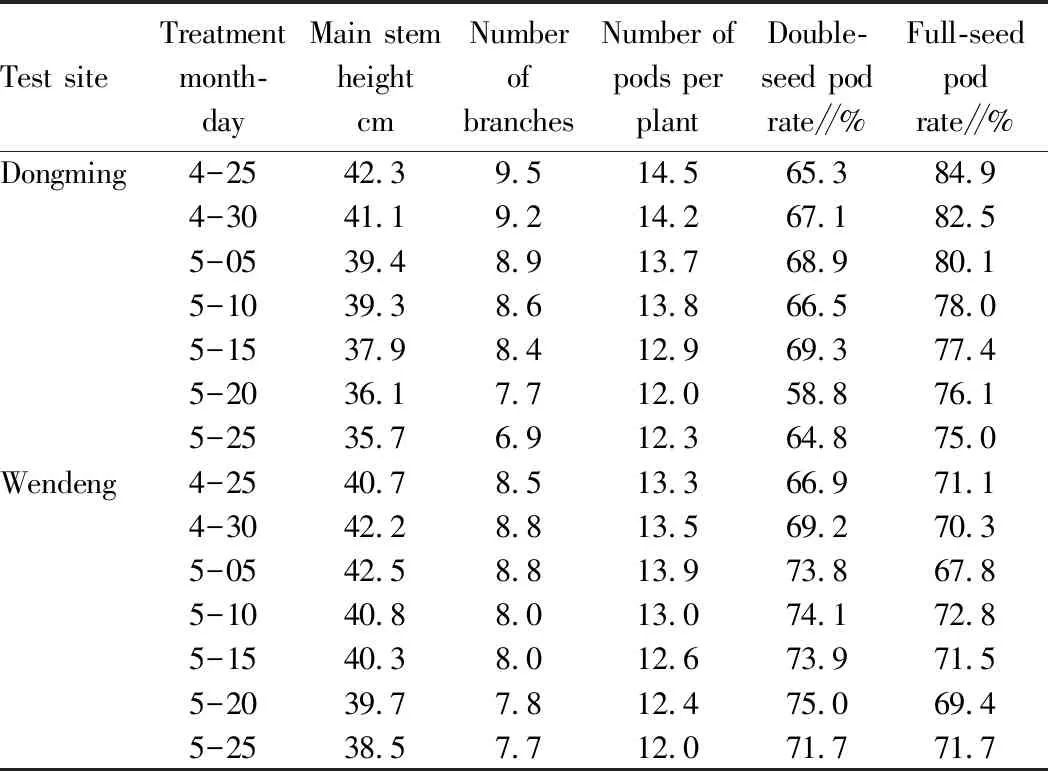
Test siteTreatmentmonth-dayMain stemheightcmNumberofbranchesNumber ofpods perplantDouble-seed podrate∥%Full-seedpodrate∥%Dongming4-2542.39.514.565.384.9 4-3041.19.214.267.182.55-0539.48.913.768.980.1 5-1039.38.613.866.578.0 5-1537.98.412.969.377.4 5-2036.17.712.058.876.1 5-2535.76.912.364.875.0 Wendeng4-2540.78.513.366.971.1 4-3042.28.813.569.270.3 5-0542.58.813.973.867.8 5-1040.88.013.074.172.8 5-1540.38.012.673.971.5 5-2039.77.812.475.069.4 5-2538.57.712.071.771.7
3.1.2Effects on the yield. With the delay of the sowing date, the yield of Dongming test site gradually decreased. During the month from April 25 to May 25, the yield had a linear relationship with the sowing date,y=-229.86x+6 031.4 (xdenotes the sowing date number, the same as below), the correlation coefficient (R) was as high as 0.945 3, reaching an extremely significant level. According to the linear equation, from April 25, the yield decreased by 229.86 kg/ha for every five days of delay. Analysis of variance of different treatments showed that the treatment of sowing on April 25 was significantly higher than that of other sowing dates. In Wendeng test site, the yield increased first and then decreased with the delay of the sowing date. The relationship between the two can be expressed by the equationy=-126.63+837.39x+ 6 249.4, andR2=0.897 3. According to the measured values, the sowing date of May 10 had the highest yield of 7 693.6 kg/ha, followed by May 5 and April 30, the yield was 7 679.6 kg/ha and 7 603.8 kg/ha, respectively. The difference between the three treatments was not significant, but all were significantly higher than other treatments. Therefore, the appropriate sowing date for Wendeng is April 30 to May 10, and the most appropriate sowing date is May 5, as shown in Fig.1.
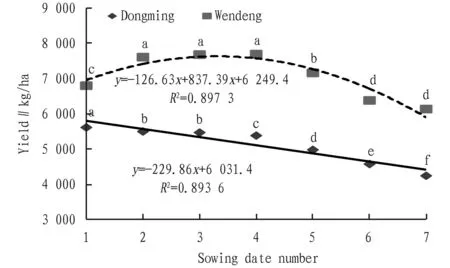
Note: sowing date number 1, 2, 3,...,7 denotes sowing date April 25, April 30, May 5, May 10, May 15, May 20, and May 25, respectively.
Fig.2 Effects of sowing date on the yield
3.1.3Relationship between the yield and agronomic traits. In Dongming test site, the yield, main stem height, the number of branches, and the number of pods per plant reached the extremely significant level, and the full-seed pod rate reached the significant level; in Wendeng test site, only the main stem height, the number of pods per plant, and the yield reached the significant level. These results indicate that the peanut yield mainly depends on the plant height and the number of pods per plant, while the plant height represents the development degree of vegetative of ground parts and the number of pods per plant reflects the production capacity of a single plant. These two indicators can be used as main indicators for determining whether the peanut sowing date is appropriate. In addition, the main stem height, the number of branches, and the number of pods per plant of both test sites reached extremely significant level, indicating that the plant height is favorable for promoting the development of lateral branches and promoting the formation of pods.
Table 2 Relationship between the yield and main agronomic traits

ItemDongmingYieldMain stemheightNumber ofbranchesNumber ofpods perplantDouble-seedpodrate∥%Wendeng YieldMain stemheightNumber ofbranchesNumber ofpods perplantDouble-seedpodrate∥%Main stem height0.940 1∗∗0.874 3∗Number of branches0.977 0∗∗0.956 2∗∗0.671 70.919 3∗∗Number of pods per plant0.942 0∗∗0.977 4∗∗0.915 9∗∗0.795 3∗0.962 9∗∗0.948 3∗∗Double-seed pod rate∥%0.516 70.432 00.451 40.537 20.062 6-0.153 6-0.477 5-0.295 5Full-seed pod rate∥%0.861 4∗0.966 8∗∗0.916 1∗∗0.906 3∗∗0.305 8-0.117 4-0.497 2-0.522 5-0.490 4-0.146 9
Note:**denotes significant at 0.01 level, and*denotes significant at 0.05 level.
3.2 Effects of density on Huayu 22 Peanut
3.2.1Effects on agronomic traits. With the increase of the density, the main stem height, lateral branch length and the number of pods per plant showed a decline trend, the density had little effect on the number of branches per plant, and the double-seed pod rate was the highest at 120 000 holes/ha, the full-seed pod rate were the highest at 150 000 holes/ha, indicating that the density of 90 000-150 000 holes/ ha is favorable for growth of the plant vegetative and the improvement of the yield traits (Table 3).
Table 3 Effects of density on agronomic traits
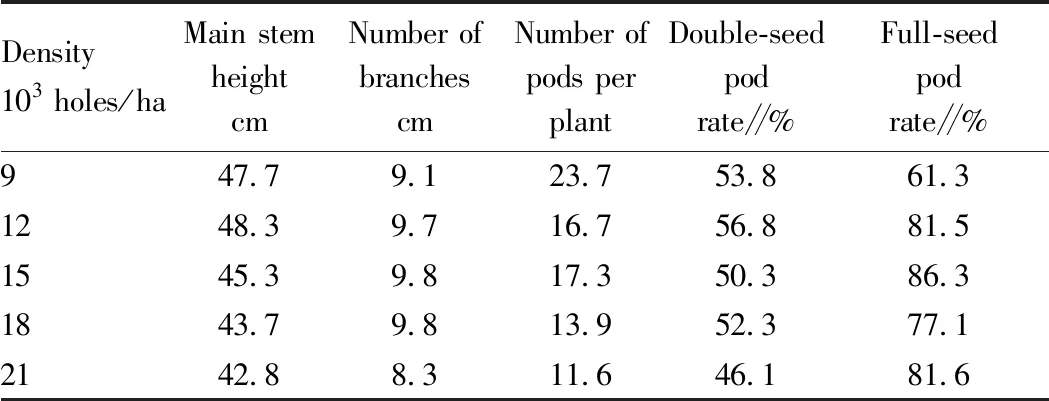
Density103 holes/haMain stemheightcmNumber ofbranchescmNumber ofpods perplantDouble-seedpodrate∥%Full-seedpodrate∥%947.79.123.753.861.3 1248.39.716.756.881.5 1545.39.817.350.386.3 1843.79.813.952.377.1 2142.88.311.646.181.6
3.2.2Effects on the yield. With the increase of planting density, the yield showed a parabolic trend, first increased and then decreased. The density of 150 000 holes/ha had the highest yield, up to 8 370 kg/ha, which was significantly different from that of other treatments. Then it was 120 000 holes/ha and 180 000 holes/ha, the difference between them is not significant, but significant higher than 90 000 holes/ha and 210 000 holes/ha treatments, indicating that the most appropriate density for Huayu 22 Peanut is 150 000 holes/ha, too high or too low density is not favorable for high yield. The relationship between yield and density can be expressed by the quadratic equationy=-38.571x2+1 149.9x-611.89, and the coefficient of determinationR2=0.803 5. According to the equation, the optimum value of density can be inferred to be 1 49 000 holes/ha, which is highly consistent with the measured value of 150 000 holes/ha (Fig.2).
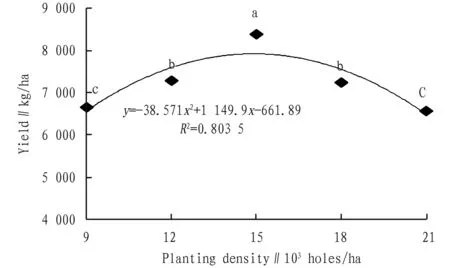
Fig.2 Effects of density on the yield
4 Conclusions and discussions
4.1 Sowing dateAccording to the study of Zhen Zhigaoetal.[2], with the delay of the sowing date, the plant height, lateral branch length, the number of branches, the number of branches with pods and the number of pods per plant decreased, while the sowing date of May 30 had the highest 100-pod weight and pod ield per plant. However, according to the findings of Yin Dongmeietal.[3], the sowing date had little effect on the plant height. With the delay of the sowing date, the 100-pod weight, 100-seed weight, and percentage of polished peanut decreased, while the effect of sowing date on the number of pod per plant and total number of branches per plant was not regular. The experimental results of Wang Junqiangetal.[6]indicate that in the period from April 15 to May 14, with the delay of the sowing date, the main stem height, the lateral branch length and the number of branches were high in two ends and low in the middle, and they were the lowest in April 30. The above three indicators were too high or too low, and are not favorable for the formation of high yield, the moderate level is optimum. For different sowing dates, there is no significant difference in the number of branches with pods. As found by Chen Jianshengetal.[7], with the delay of the sowing date, both the main stem height and the lateral branch length increased, large peanuts were high in two ends and low in the middle, while small peanuts showed a decreasing trend, and the number of pods per plant also showed a decreasing trend. According to the study of Wu Zhihuietal.[10], in the period from April 23 to May 18, with the delay of the sowing date, the main stem height became shorter, the sowing date before May 3 had the larger number of pods per plant, but the 100-pod weight and 100-seed weight decreased with the delay of the sowing date, and the sowing date before May 8 had higher shelling percentage. According to the experiment of Wang Jiqingetal.[11], the number of pods per plant, 100-pod weight and 100-seed weight first increased then decreased, and the sowing date before May 1 was the highest. In this experiment, with the delay of sowing date, in Dongming test site, the main stem height, the number of branches per plant, the number of pods per plant and the full-seed pod rate decreased, while the double-seed pod rate was not affected, generally consistent with findings of Zhen Zhigaoetal.[2]. Different from the Dongming test site, the main agronomic traits of the Wendeng test site increased first and then decreased with the delay of sowing date. Specifically, the sowing date of May 5 had the main stem height, number of branches, and the number of pods per plant, showing the best performance; the sowing date of May 20 had the highest double-seed pod rate; the sowing date of May 10 had the highest full-seed pod rate. The reasons for the differences in the main agronomic traits of different tests are mainly related to the differences in ecological conditions at the test sites and the selected range of sowing dates.
Similar to the main agronomic traits in the sowing date, the appropriate sowing dates in different ecological areas are also quite different. In this experiment, with the delay of the sowing date, the yield of Dongming test site gradually decreased. In the period from April 25 to May 25, the yield decreased by 229.86 kg/ha for every delay of five days. The most appropriate sowing date is April 25, similar to the findings of Zhang Lin et al[5]. In Wendeng test site, with the delay of the sowing date, the yield first increased then decreased, the sowing date of May 10 had the highest yield, followed by May 5 and April 30. The difference between the three treatments was not significant, but all were significantly higher than other treatments. Therefore, the appropriate sowing date for Wendeng is April 30 to May 10, and the most appropriate sowing date is May 5. This results is consistent with the findings of Wang Junqiang[6], Chen Jianshengetal.[7], and Chen Jingjingetal.[9].
4.2 DensityAccording to research results of Yin Dongmeietal.[4], the effects of density are little on the plant height, 100-seed weight and shelling percentage, but are significant on the total branching number, the number of pods per plant, pod yield per plant, and 100-pod weight, with the increase of the density, these indicators gradually decrease. According to the study of Chen Jianhong[4], with the increase of the density, the main stem height increased, the number of branches, the pod yield per plant, the number of pods per plant, and the 100-pod weight decreased, but the full-seed pod rate and shelling percentage increased with the increase of the density. According to the findings of Chen Zhidengetal.[21], with the increase of the density, the main stem height, lateral branch length, the number of branches, the number of pods per plant, the number of pods, the number of full-seed pods, 100-pod weight, and shelling percentage decreased. According to the findings of Zhou Yanzhongetal.[22], with the increase of the density, the main stem height, lateral branch length, the number of branches, and the number of pods per plant were high in the middle and low in the two ends, while the full-seed pod rate, 100-pod weight, and shelling percentage decreased. According to this experiment, with the increase of the density, the main stem height and the number of pods per plant showed a decline trend, the density had little effect on the number of branches per plant, and the double-seed pod rate was the highest at 120 000 holes/ha, the full-seed pod rate were the highest at 150 000 holes/ha. The reasons for the differences in the above findings may be related to the selected variety and the range of densities involved.
The appropriate density of peanuts obtained by different researchers is quite different. Chen Zhideetal.[21]obtained 120 000 holes/ha, Hao Tianhaoetal.[17]obtained 133 000-138 000 holes/ha, and Yu Weietal.[14]obtained 160 000 holes/ha, Zhou Yanzhongetal.[22]obtained not less than 165 000 holes/ha, Li Qiangetal.[19]obtained 165 000-195 000 holes/ha, Chen Jianhong[16]obtained 180 000 holes/ha. In this experiment, with the increase of the density, the yield showed a parabolic trend first increased and then decreased. The density of 150 000 holes/ha had the highest yield, up to 8 370 kg/ha, which was significantly different from that of other treatments. Then it was 120 000 holes/ha and 180 000 holes/ha, the difference between them is not significant, but significant higher than 90 000 holes/ha and 210 000 holes/ha treatments, indicating that the most appropriate density for Huayu 22 Peanut is 150 000 holes/ha, too high or too low density is not favorable for high yield. The main reasons for the above different results lie in the differences in varieties selected by different experiments, local climatic conditions, soil fertility and fertilizer management levels, among which the variety is the primary factor affecting the density[13].
杂志排行
Asian Agricultural Research的其它文章
- Personnel Cultivation Program for Innovative and Entrepreneurial Biopharmaceutical Discipline under the Credit System
- Screening and Analysis of Cadmium-tolerant Rice Variety Resources
- Comparison of Soil Nutritional Status between Different Muscat Hamburg Vineyards in Coastal Areas of Tianjin
- Drought Tolerance Identification and Eevluation of Maize during Flowering Stage in Guangxi
- The Model of "Party Branch+" in Promoting Industrial Poverty Alleviation in Poverty-stricken Mountainous Areas of China: A Case Study of Xundian in Yunnan Province
- Industrial Poverty Alleviation Model in Deep Poverty-stricken Villages in the Dry-hot Valley of Jinsha River: A Case Study of Poverty Alleviation in the Green Prickleyash Planting Industry in Laopingzi Village, Luquan County
